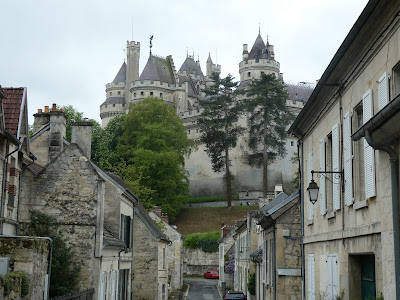The good thing about weather forecasts is that, while they are sometimes right, they are often wrong. The forecasts had predicted inclement weather every day beginning on Friday, May 5, and while it's raining steadily today (thus keeping us in the town of Compiegne for another day), the last few days have not been all bad.
 |
| Proof that we actually saw the sun at times as we cruised on Saturday, May 6, on our way to Compiegne. |
 |
| We are moored in just about the same spot we were last year. |
In this location we have a front-row seat to the happenings on the river.
 |
| Sunday was a day when, despite the damp greyness, rowing club boats and other water recreation craft--including these dragon boats-- were out and about. |
The water view is lovely, but the opposite side of the boat is very close to pedestrian and bicycle traffic. Most of the attention that C.A.R.I.B. III gets from passersby is positive. . . . . .
 |
| The little boy was fascinated by our boat, so we invited the family aboard to take some photos. |
. . . . . . but the "good vibes" are not universal. At about 10 p.m. on the first night we were here, we heard voices outside the boat, then a small "clunk", as though something had been thrown against the side. By the time we opened the door to look, there was no one around, but we couldn't see that anything was amiss. However, the daylight of the following day told a different story, and we could see that one of our mooring attachments had been interfered with.
 |
| With no bollards or cleats to tie to, we had to wrap lines around concrete, and used a U-bolt to close the loop. We had a set-up like this both fore and aft. |
It never ceases to amaze us that some people find their entertainment in trying to create dangerous situations. This is not the first time we've heard of miscreants untying boats, but it is the first time that we've been the recipients of the action. Needless to say, we reconfigured our attachments.
On Monday, May 8 (a holiday in France, Victory in Europe Day), we made an excursion to the nearby village of Pierrefonds. A 10-mile bike ride through the forest of Compiegne to the east got us to our destination, whose claim to fame is the amazing, fortified chateau de Pierrefonds.
 |
| The chateau de Pierrefonds rises over the village of Pierrefonds. |
The current chateau is a 19th century restoration of a castle that was originally constructed at the end of the 12th century as a strategic, defensive stronghold for Paris. In 1617, King Louis XIII decided to dismantle several fortresses in order to weaken his political opponents. The chateau of Pierrefonds was one of the castles slated for destruction.
The restoration work extended over thirty years--beyond the deaths of both Viollet-le-Duc and Napoleon III. The result was not an exact replica of the original building, but a reinterpretation of the Middle Ages and the "perfect" castle of that age. It was never a royal residence, although it did serve as barracks in World War I.
 |
| Pat waiting to enter the castle courtyard via drawbridge. |
 |
| Interior of the chapel |
 |
| The chateau looms over the town. It is undergoing repairs, hence the scaffolding over an extensive portion of the castle. |
 |
| The inner courtyard. |
 |
| Fantastic water drain; it made us think of Florida alligators. |
 |
| Mythical creatures line the stairwells. |
 |
| The guard (or mercenary) room. The stone fragments were found during excavations prior to renovations. |
 |
| Definitely not a feature of the Middle Ages: a flush toilet! |
 |
| A model of the castle, created for an exposition in Paris in 1878. |
 |
| Lon in the Reception Room. |
 |
| The base of the cellar walls is 14th century, but the vaults are 19th century. The cellar contained nearly 100 funerary models of people prominent in French history. |
We had hoped to leave Compiegne today, but the rain is constant and it just seemed too wet to deal with locks. So, we've used the time to do some needed shopping, and then just relax. Tomorrow the forecast calls for the rain to be lighter, so we hope we'll be able to head out in the morning. Meanwhile, it's a perfect evening for soup!



No comments:
Post a Comment